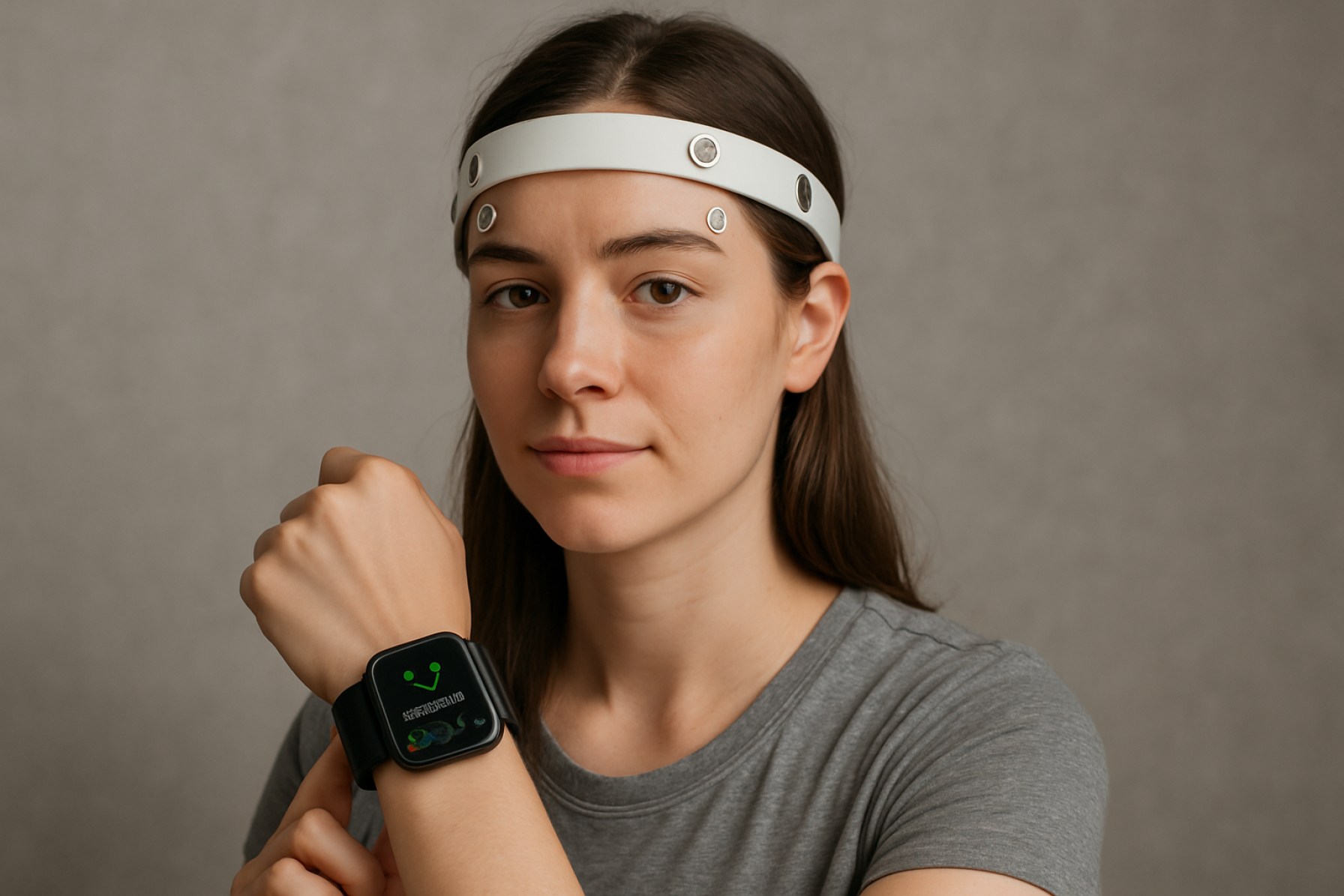Revolutionizing Mental Health: How Wearable Monitoring Systems Are Transforming Care in 2025 and Beyond. Explore the Breakthroughs, Market Surge, and Future Impact of Smart Mental Health Wearables.
- Executive Summary: Key Trends and Market Drivers in 2025
- Market Size, Growth Rate, and Forecast (2025–2030)
- Technology Landscape: Sensors, AI, and Data Analytics
- Leading Companies and Innovators (e.g., apple.com, fitbit.com, emotiv.com)
- Clinical Applications: From Early Detection to Ongoing Management
- Regulatory Environment and Data Privacy Challenges
- Integration with Healthcare Systems and Telemedicine
- Consumer Adoption: Barriers, Motivators, and Demographics
- Investment, M&A, and Startup Ecosystem
- Future Outlook: Opportunities, Risks, and Strategic Recommendations
- Sources & References
Executive Summary: Key Trends and Market Drivers in 2025
The wearable mental health monitoring systems sector is experiencing rapid evolution in 2025, driven by advances in sensor technology, artificial intelligence (AI), and growing societal focus on mental well-being. The integration of physiological and behavioral data collection into consumer wearables is enabling real-time, continuous mental health insights, moving beyond traditional episodic self-reporting. This shift is supported by a convergence of healthcare, technology, and regulatory trends, positioning wearables as a critical tool in early detection, intervention, and management of mental health conditions.
Key industry players are expanding their portfolios to include mental health features. Apple Inc. has enhanced its Apple Watch with features that monitor mood, sleep, and stress, leveraging heart rate variability and machine learning to provide users with actionable mental health feedback. Similarly, Fitbit, now part of Google, continues to refine its Sense series with electrodermal activity (EDA) sensors and stress management tools, while Samsung Electronics integrates mental health tracking into its Galaxy Watch line, focusing on sleep quality and stress detection.
The sector is also witnessing the emergence of specialized startups and medical device companies. Empatica offers FDA-cleared wearables capable of detecting physiological markers associated with stress and emotional states, targeting both clinical and consumer markets. Withings and Garmin are incorporating advanced biosensors and analytics to support mental health monitoring, while Biobeat focuses on medical-grade remote patient monitoring, including mental health parameters.
Data privacy and regulatory compliance are increasingly central, with companies aligning with evolving standards such as the EU’s Medical Device Regulation (MDR) and the U.S. FDA’s digital health frameworks. Partnerships between technology firms and healthcare providers are expanding, aiming to integrate wearable-derived mental health data into electronic health records and telehealth platforms.
Looking ahead, the market is expected to see further integration of AI-driven predictive analytics, enabling proactive mental health interventions. The adoption of multi-modal sensors—combining physiological, voice, and behavioral data—will enhance accuracy and personalization. As stigma around mental health continues to decrease and reimbursement models evolve, adoption rates are projected to accelerate, particularly in corporate wellness, insurance, and remote care settings. The next few years will likely see wearables transition from wellness tools to validated medical devices, fundamentally reshaping mental health care delivery.
Market Size, Growth Rate, and Forecast (2025–2030)
The market for wearable mental health monitoring systems is poised for significant expansion in 2025 and the subsequent years, driven by technological advancements, increased mental health awareness, and integration with digital health ecosystems. As of 2025, the global market size for these systems is estimated to be in the low single-digit billions (USD), with projections indicating a robust compound annual growth rate (CAGR) exceeding 20% through 2030. This growth is underpinned by the convergence of biosensor innovation, artificial intelligence, and the proliferation of consumer-grade and clinical-grade wearables.
Key industry players are shaping the market landscape. Apple Inc. continues to expand the mental health capabilities of its Apple Watch, introducing features such as mood tracking and mental health assessments integrated with its Health app. Fitbit (now part of Google) has incorporated stress management tools and electrodermal activity sensors in its latest devices, targeting both consumer wellness and clinical research applications. Samsung Electronics is also investing in mental health monitoring, leveraging its Galaxy Watch platform to provide stress and sleep tracking functionalities.
On the clinical side, companies like Empatica are advancing FDA-cleared wearables capable of continuous physiological monitoring, including indicators relevant to mental health such as electrodermal activity, heart rate variability, and sleep patterns. Biobeat and Withings are similarly expanding their portfolios to include mental health-relevant metrics, aiming to bridge the gap between consumer and medical-grade solutions.
The adoption of wearable mental health monitoring systems is being accelerated by partnerships with healthcare providers, integration with telehealth platforms, and growing employer interest in workforce mental well-being. Regulatory support for digital therapeutics and remote patient monitoring is also expected to catalyze market growth, particularly in North America and Europe.
Looking ahead to 2030, the market outlook remains highly positive. The increasing prevalence of mental health conditions, combined with the normalization of wearable technology in daily life, is expected to drive both consumer and clinical adoption. Ongoing improvements in sensor accuracy, data analytics, and interoperability with electronic health records will further solidify the role of wearables in mental health management. As a result, the wearable mental health monitoring systems market is anticipated to become a cornerstone of the broader digital health industry by the end of the decade.
Technology Landscape: Sensors, AI, and Data Analytics
The technology landscape for wearable mental health monitoring systems in 2025 is characterized by rapid advancements in sensor miniaturization, artificial intelligence (AI), and data analytics. These systems are increasingly leveraging multi-modal sensor arrays, sophisticated machine learning algorithms, and secure cloud-based platforms to provide real-time, personalized mental health insights.
Sensor technology has evolved to capture a wide range of physiological and behavioral signals relevant to mental health. Modern wearables integrate photoplethysmography (PPG) for heart rate variability, electrodermal activity (EDA) for stress response, accelerometers for activity and sleep tracking, and even skin temperature sensors. For example, Empatica offers medical-grade wearables that monitor EDA, temperature, and movement, supporting detection of stress and emotional arousal. Similarly, Fitbit and Garmin have incorporated stress and sleep tracking features into their consumer devices, using heart rate and movement data to infer mental well-being.
AI and machine learning are central to transforming raw sensor data into actionable mental health insights. Algorithms are trained to detect patterns associated with anxiety, depression, and stress by analyzing physiological signals in context. Empatica employs AI-driven analytics to identify anomalies and trends, while Apple has introduced mental health features in its Apple Watch, using on-device machine learning to assess mood and mental state based on activity, sleep, and heart rate data. These systems increasingly use federated learning and edge computing to process sensitive data locally, enhancing privacy and reducing latency.
Data analytics platforms are evolving to provide users and clinicians with intuitive dashboards and actionable feedback. Withings and Garmin offer cloud-based health platforms that aggregate longitudinal data, enabling trend analysis and early detection of mental health deterioration. Integration with electronic health records (EHRs) is becoming more common, facilitating holistic care and remote monitoring by healthcare professionals.
Looking ahead, the next few years are expected to bring further integration of biosensors capable of monitoring neurochemical markers, such as cortisol, and advances in non-invasive brain activity sensing. The convergence of wearable technology, AI, and secure data infrastructure is poised to make mental health monitoring more accurate, personalized, and accessible, with major industry players and medical device companies driving innovation and regulatory compliance.
Leading Companies and Innovators (e.g., apple.com, fitbit.com, emotiv.com)
The wearable mental health monitoring sector in 2025 is characterized by rapid innovation and the entry of both established technology giants and specialized neurotechnology firms. These companies are leveraging advances in biosensors, artificial intelligence, and cloud connectivity to deliver real-time insights into users’ mental well-being, stress levels, and emotional states.
Among the most prominent players, Apple Inc. continues to expand the mental health capabilities of its Apple Watch platform. In 2024, Apple introduced new features in watchOS that use heart rate variability, sleep patterns, and even voice analysis to detect signs of anxiety and depression. The company’s Health app now integrates mood tracking and offers users personalized recommendations, positioning Apple as a leader in consumer-grade mental health monitoring.
Another major force is Fitbit, now part of Google, which has integrated stress management tools and electrodermal activity (EDA) sensors into its latest wearables. Fitbit’s devices can track physiological signals associated with stress and provide guided breathing exercises, with data accessible through the Fitbit app. The company is also exploring partnerships with healthcare providers to enable remote mental health monitoring and early intervention.
In the neurotechnology space, EMOTIV stands out for its EEG-based headsets that monitor brain activity related to mood, focus, and cognitive stress. EMOTIV’s products are used in both research and consumer wellness applications, and the company is actively developing cloud-based analytics platforms to interpret neural data for mental health insights. Their technology is increasingly being adopted in workplace wellness programs and clinical research.
Other innovators include Muse, which offers EEG headbands for meditation and stress reduction, and Withings, which has expanded its health tracking ecosystem to include mental well-being metrics derived from sleep and heart rate data. Both companies are focusing on seamless integration with mobile health platforms and user-friendly feedback.
Looking ahead, the next few years are expected to see further convergence between wearable hardware and digital therapeutics, with companies like Apple and Fitbit exploring FDA-cleared features for mental health screening. Partnerships with healthcare systems and insurers are likely to accelerate, as real-world data from wearables becomes increasingly valuable for preventive care and personalized mental health interventions.
Clinical Applications: From Early Detection to Ongoing Management
Wearable mental health monitoring systems are rapidly transitioning from experimental tools to clinically relevant solutions, with 2025 marking a pivotal year for their integration into healthcare workflows. These systems leverage biosensors embedded in smartwatches, patches, and other wearables to continuously track physiological and behavioral markers—such as heart rate variability, sleep patterns, skin conductance, and activity levels—associated with mental health conditions. The clinical applications span early detection, real-time symptom monitoring, and ongoing management of disorders like depression, anxiety, and bipolar disorder.
A key development in 2025 is the increasing adoption of wearable devices in large-scale clinical studies and real-world healthcare settings. For example, Apple Inc. has expanded the mental health features of its Apple Watch, enabling users to log mood, track sleep, and receive notifications about potential mental health concerns based on physiological data. These features are being integrated into clinical research partnerships with academic medical centers to validate their utility in early detection and intervention.
Similarly, Fitbit (now part of Google) continues to enhance its wearables with stress management tools, including electrodermal activity (EDA) sensors and advanced sleep analytics. In 2025, Fitbit’s collaborations with healthcare providers are focusing on using aggregated wearable data to support clinicians in monitoring patients with diagnosed mental health conditions, enabling more personalized and timely interventions.
Another notable player, Empatica, specializes in medical-grade wearables approved for clinical use. Its EmbracePlus device, which measures multiple physiological signals, is being deployed in mental health research and remote patient monitoring programs. Empatica’s partnerships with hospitals and pharmaceutical companies are aimed at integrating continuous mental health monitoring into clinical trials and chronic care management.
The clinical outlook for wearable mental health monitoring systems in the next few years is shaped by several trends:
- Regulatory progress: Devices are increasingly seeking and obtaining regulatory clearances for mental health applications, supporting their use in formal care pathways.
- Integration with electronic health records (EHRs): Major wearable manufacturers are working on secure data sharing protocols to allow clinicians to access and interpret wearable-derived mental health data within existing EHR systems.
- Personalized interventions: AI-driven analytics are being developed to translate wearable data into actionable insights, enabling tailored interventions and just-in-time support for patients.
As these systems mature, their role in early detection, relapse prevention, and ongoing management of mental health conditions is expected to expand, with 2025 serving as a launchpad for broader clinical adoption and evidence-based integration into mental healthcare.
Regulatory Environment and Data Privacy Challenges
The regulatory environment for wearable mental health monitoring systems is rapidly evolving in 2025, reflecting both the promise and the complexity of these technologies. As wearables increasingly incorporate advanced biosensors and AI-driven analytics to detect and monitor mental health indicators such as stress, mood, and sleep patterns, regulators are intensifying their scrutiny to ensure user safety, data accuracy, and privacy.
In the United States, the U.S. Food and Drug Administration (FDA) continues to refine its approach to digital health devices, including wearables with mental health applications. While many consumer-grade devices are classified as wellness products and thus not subject to premarket approval, the FDA has signaled that systems making clinical claims—such as diagnosing depression or anxiety—may require clearance or approval. In 2024 and 2025, the FDA has issued new guidance clarifying the distinction between general wellness devices and those considered medical devices, with a focus on transparency in algorithmic decision-making and risk management.
In Europe, the European Medicines Agency (EMA) and national regulators are enforcing the Medical Device Regulation (MDR), which came fully into effect in 2021 but continues to impact the wearable sector. Companies such as Withings and Fitbit (now part of Google) have adapted their product development and data handling practices to comply with MDR requirements, particularly regarding clinical evidence and post-market surveillance for devices with mental health monitoring features.
Data privacy remains a central challenge. The sensitive nature of mental health data collected by wearables has prompted stricter enforcement of privacy laws such as the EU’s General Data Protection Regulation (GDPR) and the California Consumer Privacy Act (CCPA). Companies like Apple and Samsung Electronics have publicly emphasized their commitment to on-device data processing and user consent, aiming to minimize risks of data breaches and unauthorized sharing. Apple, for example, has expanded its privacy features in the Health app, giving users granular control over what mental health data is shared and with whom.
Looking ahead, the regulatory landscape is expected to become more harmonized internationally, with ongoing collaboration between agencies such as the FDA, EMA, and the International Organization for Standardization (ISO) to develop standards for data security, interoperability, and ethical AI use in mental health wearables. However, as device capabilities advance, regulators and manufacturers alike will face ongoing challenges in balancing innovation with the imperative to protect user privacy and safety.
Integration with Healthcare Systems and Telemedicine
The integration of wearable mental health monitoring systems with healthcare systems and telemedicine platforms is accelerating in 2025, driven by advances in sensor technology, data analytics, and interoperability standards. Wearables capable of tracking physiological and behavioral indicators—such as heart rate variability, sleep patterns, and electrodermal activity—are increasingly being linked to electronic health records (EHRs) and telehealth services, enabling more comprehensive and continuous mental health care.
Major device manufacturers are actively pursuing partnerships with healthcare providers and digital health platforms to facilitate seamless data exchange. For example, Apple Inc. continues to expand the mental health features of its Apple Watch, including mood tracking and mental wellness notifications, and is working to ensure that data collected can be securely shared with healthcare professionals through HealthKit and integrated EHR systems. Similarly, Fitbit (now part of Google) is enhancing its devices’ capabilities to monitor stress and sleep, and is collaborating with healthcare organizations to incorporate these metrics into patient care workflows.
On the telemedicine front, leading virtual care providers are integrating wearable data into their platforms to support remote mental health assessments and interventions. Teladoc Health, a prominent telehealth company, has announced initiatives to incorporate data from consumer wearables into its mental health services, allowing clinicians to monitor patients’ well-being between sessions and intervene proactively when concerning trends are detected. This approach is being mirrored by other telemedicine platforms, which are leveraging APIs and secure data-sharing protocols to connect with a growing ecosystem of wearable devices.
Interoperability remains a key focus area, with industry groups such as Health Level Seven International (HL7) promoting standards like FHIR (Fast Healthcare Interoperability Resources) to ensure that wearable-generated data can be easily and securely integrated into clinical systems. In 2025, several pilot programs are underway in the US and Europe to test large-scale integration of wearable mental health data with hospital EHRs, aiming to streamline care coordination and enable population-level mental health monitoring.
Looking ahead, the next few years are expected to see broader adoption of wearable mental health monitoring in clinical practice, supported by regulatory guidance and reimbursement models that recognize the value of continuous, real-world data. As device accuracy improves and privacy safeguards are strengthened, wearables are poised to become a routine component of telemedicine and integrated behavioral health care, offering new opportunities for early intervention and personalized treatment.
Consumer Adoption: Barriers, Motivators, and Demographics
Consumer adoption of wearable mental health monitoring systems in 2025 is shaped by a complex interplay of technological, psychological, and societal factors. As these devices move beyond early adopters, understanding the barriers, motivators, and demographic trends is crucial for stakeholders aiming to expand their reach.
Barriers to Adoption remain significant. Privacy concerns are paramount, as users are wary of sharing sensitive mental health data, even with assurances of encryption and anonymization. The potential for data misuse or breaches, especially given the intimate nature of mental health metrics, is a persistent worry. Additionally, skepticism about the clinical accuracy and efficacy of consumer-grade devices persists, despite advances in sensor technology and algorithmic validation. Cost is another barrier, as advanced wearables with mental health features often command premium prices, limiting accessibility for lower-income populations. Usability challenges, such as device comfort, battery life, and the need for regular calibration, also deter some potential users.
On the other hand, several motivators are driving adoption. The growing societal focus on mental well-being, accelerated by the lingering effects of the COVID-19 pandemic, has normalized conversations around mental health and increased demand for self-monitoring tools. Wearables now offer features such as continuous stress tracking, mood journaling, and guided breathing exercises, which appeal to users seeking proactive management of their mental state. Integration with broader health ecosystems—such as compatibility with smartphones and telehealth platforms—enhances the perceived value of these devices. Companies like Fitbit (now part of Google), Apple, and Samsung Electronics have incorporated mental health features into their mainstream wearables, increasing visibility and trust.
Demographic trends indicate that adoption is highest among younger adults (ages 18–35), who are more comfortable with technology and more open to digital health solutions. This cohort is also more likely to prioritize mental health and seek tools for self-improvement. However, there is growing interest among older adults, particularly as device interfaces become more user-friendly and as mental health monitoring is increasingly linked to overall wellness and chronic disease management. Gender differences are also notable, with women generally more likely to use mental health features, reflecting broader trends in health-seeking behavior.
Looking ahead, the outlook for consumer adoption is positive, with continued innovation expected to address current barriers. As companies like Withings and Garmin expand their mental health offerings and regulatory clarity improves, broader demographic segments are likely to embrace these systems. The next few years will likely see increased personalization, improved data security, and deeper integration with healthcare providers, further motivating adoption across diverse populations.
Investment, M&A, and Startup Ecosystem
The wearable mental health monitoring systems sector is experiencing a surge in investment and startup activity as the demand for real-time, non-invasive mental health solutions grows. In 2025, venture capital and corporate investors are increasingly targeting companies that integrate biosensors, artificial intelligence, and cloud-based analytics to detect and manage mental health conditions such as stress, anxiety, and depression.
Major technology and healthcare companies are actively expanding their portfolios through acquisitions and strategic partnerships. Apple Inc. continues to enhance its Apple Watch platform with mental health features, including mood tracking and stress detection, and has reportedly engaged in partnerships with mental health app developers to expand its ecosystem. Fitbit, now part of Google, is leveraging its established user base and sensor technology to develop advanced algorithms for mental health monitoring, with ongoing collaborations with academic institutions and digital therapeutics startups.
The startup ecosystem is vibrant, with several companies securing significant funding rounds in late 2024 and early 2025. For example, Empatica, known for its FDA-cleared wearable devices for seizure detection, has expanded its focus to include stress and mood monitoring, attracting new investment from both healthcare and technology funds. BioSerenity, a French medtech company, is scaling its wearable EEG and biosignal platforms for mental health applications, following a series of funding rounds and hospital partnerships across Europe and North America.
Mergers and acquisitions are shaping the competitive landscape. In early 2025, several mid-sized digital health companies have been acquired by larger medical device manufacturers seeking to integrate mental health monitoring into their product lines. Philips and Siemens Healthineers have both signaled interest in expanding their digital health portfolios, with ongoing discussions and pilot projects involving wearable mental health technologies.
Looking ahead, the sector is expected to see continued consolidation as established players seek to acquire innovative startups with proprietary sensor technology or AI-driven analytics. Regulatory approvals, such as those from the FDA and CE marking in Europe, are increasingly viewed as value drivers for investment and acquisition. The next few years will likely witness a blurring of lines between consumer wellness and clinical-grade mental health monitoring, with investment flowing to companies that can demonstrate both technological innovation and clinical validation.
Future Outlook: Opportunities, Risks, and Strategic Recommendations
The future of wearable mental health monitoring systems in 2025 and the coming years is marked by rapid technological advancement, expanding clinical validation, and growing integration into healthcare ecosystems. As mental health challenges continue to rise globally, these systems are positioned to play a transformative role in early detection, continuous monitoring, and personalized intervention.
Opportunities abound as leading technology and healthcare companies invest in next-generation wearables capable of tracking physiological and behavioral markers associated with mental health. For example, Apple Inc. has expanded the capabilities of its Apple Watch to include features such as heart rate variability, sleep tracking, and mindfulness reminders, with ongoing research into detecting signs of depression and anxiety through passive data collection. Similarly, Fitbit (now part of Google) continues to enhance its devices with stress management tools and electrodermal activity sensors, aiming to provide users and clinicians with actionable insights into stress and mood fluctuations.
Clinical partnerships and regulatory engagement are accelerating. In 2024, Empatica received FDA clearance for its EmbracePlus wearable, which monitors physiological signals relevant to mental health and neurological conditions. This milestone paves the way for broader adoption in clinical trials and remote patient monitoring programs. Meanwhile, Withings and Garmin are collaborating with research institutions to validate algorithms that detect early warning signs of mental health deterioration, such as changes in sleep patterns, activity levels, and heart rate variability.
Despite these advances, significant risks and challenges remain. Data privacy and security are paramount, as wearable devices collect sensitive personal information. Companies must adhere to evolving regulations such as the EU’s GDPR and the US HIPAA, and invest in robust encryption and anonymization protocols. There is also the risk of algorithmic bias, as many current datasets lack diversity, potentially leading to less accurate assessments for underrepresented populations.
Strategic recommendations for stakeholders include prioritizing transparent data practices, fostering cross-sector collaborations with mental health professionals, and investing in inclusive research to ensure algorithms are equitable. Companies should also focus on user engagement and education, as sustained adoption depends on trust and perceived value. As reimbursement models evolve, partnerships with insurers and healthcare providers will be critical to integrating wearables into standard care pathways.
In summary, the outlook for wearable mental health monitoring systems is promising, with 2025 poised to see further convergence of technology, clinical validation, and regulatory clarity. Stakeholders who proactively address privacy, inclusivity, and clinical integration will be best positioned to capitalize on the sector’s growth and societal impact.
Sources & References
- Apple Inc.
- Fitbit
- Empatica
- Withings
- European Medicines Agency
- International Organization for Standardization
- BioSerenity
- Philips
- Siemens Healthineers










